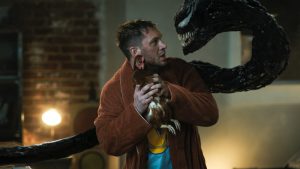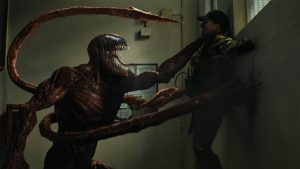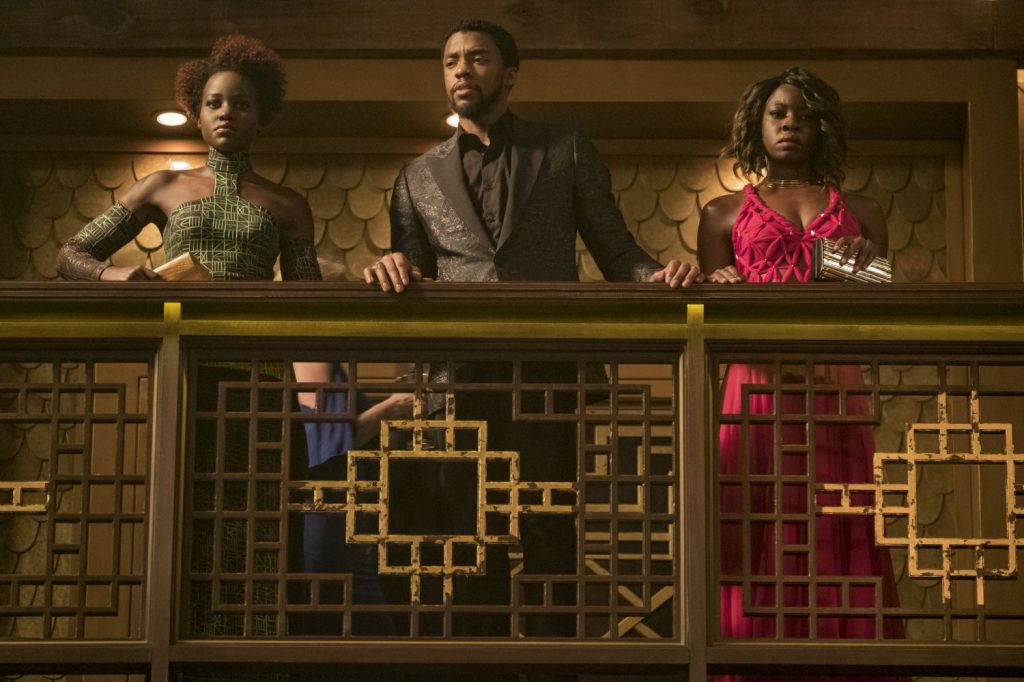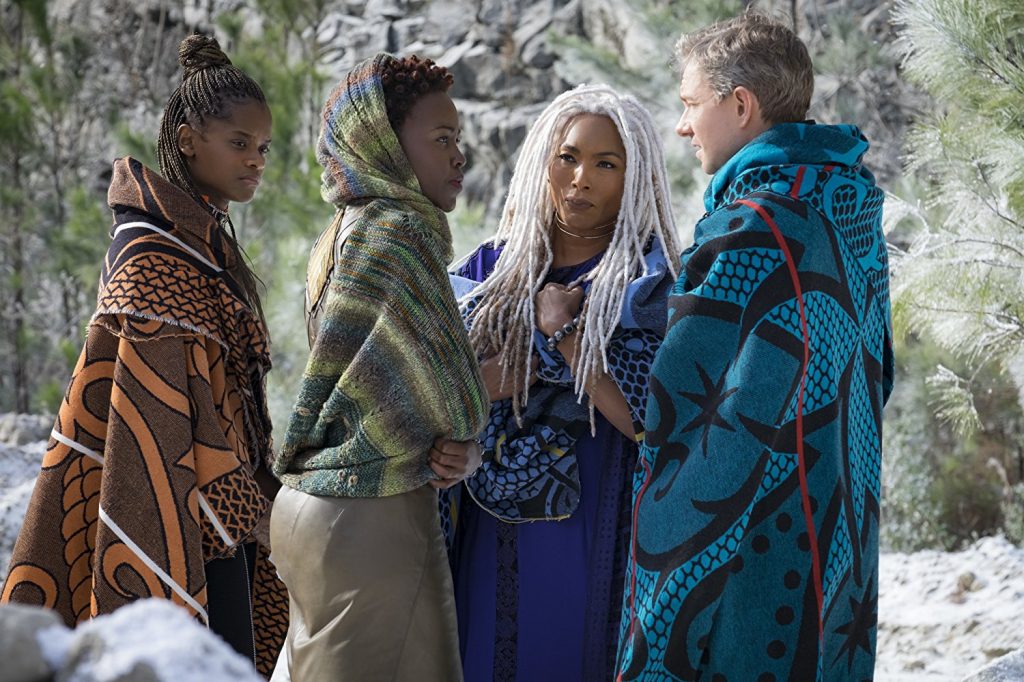February 28, 2022
by Carla Hay
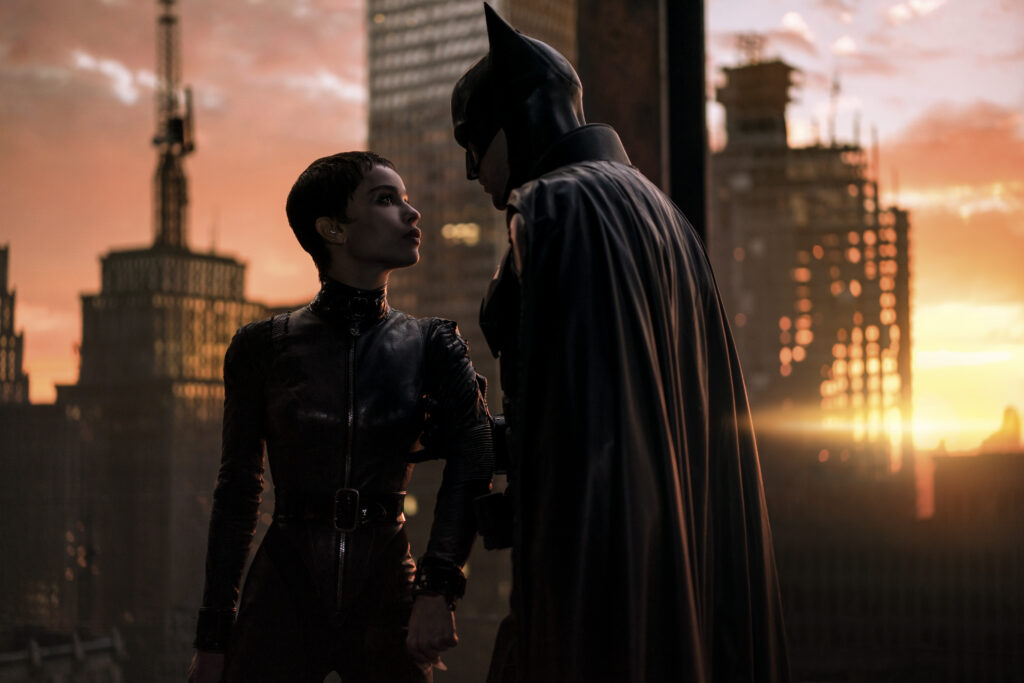
Directed by Matt Reeves
Culture Representation: Taking place in the fictional U.S. city of Gotham City, the superhero action flick “The Batman” features a predominantly white cast of characters (with some African Americans and Latinos) representing the working-class, middle-class and wealthy.
Culture Clash: Vigilante superhero Batman—the secret alter ego of orphaned billionaire Bruce Wayne—battles several villains (some more obvious than others) in a race against time to stop psychopath The Riddler, who is intent on destroying Gotham City.
Culture Audience: “The Batman” will appeal primarily to people who are interested in superhero movies with a dark and brooding tone that’s similar to director Christopher Nolan’s “Batman/The Dark Knight” movies.

Richly layered in dark intrigue and life’s shades of gray, “The Batman” takes viewers deeper into Batman/Bruce Wayne’s mind than previous “Batman” films have ever ventured. This top-notch superhero film makes pointed social commentaries about greed, corruption and responsibilities of the wealthy, in addition to delivering plenty of stunning action sequences. The movie’s total running of time of 175 minutes doesn’t make the movie feel too bloated, although at times the filmmakers’ ambitions to make “The Batman” an epic superhero film seem forced into the story a little too much, in order to justify this nearly three-hour movie.
Directed by Matt Reeves, “The Batman” is not an origin story, such as director Christopher Nolan’s 2005 movie “Batman Begins,” which was the first in Nolan’s Batman movie trilogy that continued with 2008’s “The Dark Knight” and 2012’s “The Dark Knight Rises.” Reeves co-wrote “The Batman” screenplay with Peter Craig, with the movie based on DC Comics characters created by Bob Kane and Bill Finger.
In the beginning of “The Batman,” billionaire Bruce Wayne (played by Robert Pattinson), whose secret alter ego is vigilante superhero Batman, has been fighting crime as this caped crusader for two years, mostly at night. And it’s drained his finances to the point where his trusted butler Alfred Pennyworth (played by Andy Serkis) warns Bruce that if Bruce keeps doing what he’s doing as Batman, he’ll have no more money left, and that Bruce is doing a disservice to his family’s legacy. “Alfred, stop,” Bruce says with impatience at Alfred’s worrying lecture. “You’re not my father.” Alfred replies grimly with a hint of sadness, “I’m well aware.”
As Batman fans already know, Bruce lives in the fictional U.S. city of Gotham City (also known as Gotham), which is designed to look a lot like New York City. (“The Batman” was actually filmed in the United Kingdom and Chicago.) In the movie version of the Batman saga, Bruce’s parents—billionaire philanthropists Thomas Wayne and Martha Wayne—were gunned down in front of him by an unidentified man when Bruce was 8 years old. The killer has not been caught, and his parents’ murders have haunted Bruce ever since. Thomas (played by Luke Roberts) and Martha (played by Stella Stocker) are seen in brief flashbacks in “The Batman.”
The murders of Bruce’s parents motivated Bruce to become a secret crimefighter as an adult. Finding out who killed his parents is never far from Bruce’s mind. He’s been investigating with the help of Alfred. However, Batman’s other crimefighting duties often get in the way of this investigation. In addition to being a philanthropist, Thomas Wayne was a medical doctor and a politician. He was a mayoral candidate for Gotham when he and his wife were murdered.
Bruce has no superpowers, but his wealth has allowed him to have highly sophisticated and top-level resources, weapons and equipment, including his famous Batsuit and Batmobile. In “The Batman,” Bruce also has special contact lenses, which act as hidden cameras. Gotham police summon Batman for his help, by sending out a lighted signal of distress called the Bat-Signal, which is the Batman logo that can be seen in the sky.
Out of all of the movie incarnations of Batman, “The Batman” has a tone that most closely adheres to Nolan’s “Batman/Dark Knight” trilogy, with some noticeable differences. Compared to all previous “Batman” movies, “The Batman” is much more immersive in the psychology of Bruce Wayne/Batman—so much so, that viewers can hear Bruce’s/Batman’s inner thoughts in voiceovers throughout the movie. It’s a filmmaker choice that might annoy some viewers, but in the context of “The Batman,” it works very well.
The movie’s opening scene takes viewers right into Bruce’s/Batman’s state of mind, as heard in a voiceover that says: “Two years of nights have turned me into a nocturnal animal. I must choose my targets carefully. It’s a big city. They don’t know where I am. The signal that lights up the sky is not just a call. It’s a warning to them. Fear is a tool. They think I’m lying in the shadows, but I am the shadows.”
This version of Batman has a type of inner turmoil and rage that hasn’t been seen in previous “Batman” movies. Batman famously has a personal policy to not kill people unless it’s justifiable self-defense. But in “The Batman,” this caped superhero unleashes some vicious beatings that go beyond what would be necessary to defeat an opponent. There’s a scene in the movie where Batman has to be physically stopped by law enforcement during one of these near-fatal assaults. It’s one of the reasons why Batman is feared and mistrusted by certain people who think he’s an out-of-control vigilante.
Previous “Batman” movies also made it very clear who the heroes and villains are. “The Batman” effectively blurs those lines, as secrets are revealed about several characters’ backgrounds. However, there’s no question that the chief villain of “The Batman” is a mysterious psychopath named The Riddler (played by Paul Dano), whose real name is Edward Nashton. “The Batman” reveals only a few other things about The Riddler’s personal background, since he operates and is seen mostly in the shadows.
However, there’s no doubt about The Riddler’s motives. He leaves notes and clues around Gotham to announce that his murder victims are being targeted because they are corrupt leaders who have betrayed the citizens of Gotham and beyond. The first murder is shown early on in the movie, which opens on Halloween night in Gotham.
This murder takes place 20 years (to the week) after the murders of Thomas and Martha Wayne. The target of this Halloween-night murder is “tough on crime” Mayor Don Mitchell Jr. (played by Rupert Penry-Jones), who is brutally tied up and assaulted in his own home, as he is watching himself in a pre-recorded televised candidate debate for Gotham’s next mayoral election. The incumbent mayor is home alone because his wife (played by Kosha Engler) and son (played by Archie Barnes), who do not have names in the movie, are somewhere else celebrating Halloween.
Is The Riddler acting alone, or does he have any cronies? One of the best aspects of “The Batman” is that the movie plays guessing games about where loyalties lie and whom Batman/Bruce can really trust. Bruce also finds out certain things that make him question his own motives and ethics, as well as how well he thought he knew his parents before they died. Throughout the movie, Bruce/Batman is a trusted ally of James Gordon (played by Jeffrey Wright), a lieutenant of the Gotham City Police Department, who includes Batman in the investigations and at each scene of The Riddler’s crimes.
In previous “Batman” movies, Bruce was an obvious playboy. In “The Batman,” Bruce is still a brooding eligible bachelor, but he isn’t dating anyone. However, when he meets Selina Kyle (played by Zoë Kravitz), also known as Catwoman, there’s a mutual attraction between them that sparks a little bit of romance. (They kiss each other in the movie.) Selina works as a bar server at warehouse-styled nightspot called the Iceberg Lounge, owned by shady and slippery business mogul Oswald “Oz” Cobblepot (played by Colin Farrell), also known as The Penguin.
Selina is an emotionally damaged soul whose Catwoman alter ego is a skilled and clever thief. Selina also “collects” stray cats and takes care of several of these cats in her home. In “The Batman,” Selina and Bruce cross paths because she’s investigating the disappearance of her Russian immigrant roommate Annika Kosolov (played by Hana Hrzic), whom Selina thinks has been kidnapped because Annika knew too much about a powerful man whom Annika was dating. The reasons for Annika’s disappearance (and how they all connect to a larger story) are eventually revealed in “The Batman.”
Even though Selina describes Annika to people as her “friend,” the movie hints that Annika was also Selina’s lover. Before Annika disappeared, Selina is shown comforting a distressed and fearful Annika in their apartment. Annika won’t tell Selina what’s wrong, and Selina keeps calling her “baby” and touching Annika in the way that someone would touch a lover. The movie leaves Selina’s sexuality open to interpretation because it seems the intention is that Selina is the type of person who doesn’t want to put a label on her own sexuality. Whatever the nature of Selina’s relationship is with Annika, it’s a departure from previous movie/TV characterizations of Selina, who is usually depicted as a social outcast who lives alone.
The potential romance between Batman and Catwoman is fraught with trust issues and the taboo of Batman dating someone he knows breaks the law. However, their emotional connection is powerful. Bruce and Selina both know the pain of growing up without parents and having a parent murdered. Selina’s single mother Maria (who is not seen in the movie) was strangled when Selina was 7 years old. Bruce and Selina also have the shared characteristic of having secret identities that are often misunderstood to the point where certain people don’t know if Batman and Catwoman are heroes or villains.
During the course of the movie, these other characters come into the orbit of Bruce/Batman: Carmine Falcone (played by John Turturro), a ruthless mob boss who has The Penguin as his “right-hand man”; Gil Colson (played by Peter Sarsgaard), Gotham’s district attorney who’s at the center of one of the most suspenseful scenes in the movie; Pete Savage (played by Alex Ferns), the Gotham City Police Department commissioner who doesn’t trust Batman as much as Lieutenant Gordon does; Gotham City Police Department chief Mackenzie Bock (played by Con O’Neill), who also has mistrust of Batman; and Bella Reál (played by Jayme Lawson), the young and progressive mayoral candidate who was Don Mitchell Jr.’s opponent in the mayoral race, and she is elected mayor after his death.
During all of this murder and mayhem in Gotham, Bruce finds out that he’s the target of The Riddler because The Riddler thinks that Bruce is corrupt too. Does The Riddler knows Batman’s real identity? The answer to that question is shown in the movie. There’s also some intrigue around the Wayne Foundation Renewal Fund, a charitable venture launched by Bruce’s father and is worth millions.
And in “The Batman,” the Iceberg Lounge has a “club within a club” that’s exactly what you might think it is for a nightclub that attracts a lot of powerful figures involved in criminal activities. The movie has several references to an opioid-like liquid drug called “drops,” because people take the drug through eyedrops, and addicts are called “dropheads.” Years before this story takes place, a crime lord named Salvatore Morrone (who’s never seen in the movie) was a major dealer of drops, and he got busted while Don Mitchell Jr. was mayor of Gotham. This drug bust has had long-lasting repercussions.
“The Batman” offers some biting views on how rich people throwing money at society’s problems doesn’t necessarily erase those problems if systemic inequalities still remain. Catwoman shows she has a side to her that’s about disrupting or challenging society’s institutions that are constructed to keep corrupt, privileged people in power. She’s not really an activist, but more like a social anarchist. And, for the first time in a “Batman” movie, Bruce is really taken to task by certain people for being perceived as a spoiled, wealthy heir who hasn’t really done much to help underprivileged people.
It’s not really “social justice preaching,” but it somewhat shocks Bruce to see that people seem to resent that he appears to have an “ivory tower” mindset while people are suffering around him. And to be fair, this Bruce is such a depressed recluse in “The Batman,” he’s not exactly hobnobbing at charity events as much as Bruce did in previous “Batman” movies. Alfred has to practically beg Bruce to go to a high-society fundraiser, so that Wayne Family charities can continue to operate.
As well-written as “The Batman” screenplay is, it’s hard to go wrong with such a talented group of cast members, who embody their roles as if they were born to play these characters. Pattinson has already demonstrated in plenty of his independent films that he’s got the gravitas and empathy to personify the dual roles of Batman and Bruce Wayne. Kravitz is all kinetic grace and seductive street smarts as Selina Kyle.
Farrell (who’s unrecognizable underneath exceptional prosthetic makeup) does one of the best supporting-role performances of his career as The Penguin, a menacing and sarcastic thug who isn’t in the movie as much as “The Batman” movie trailers would suggest, but he still makes an undeniable impact. Dano is chilling and unnerving as The Riddler, who’s a combination of a calculating mastermind and a loose cannon. This is not a fun-loving, impish and giggling Riddler, as seen in other “Batman” movies or TV shows. This Riddler is genuinely an infuriated and deeply disturbed villain. The cast members in the other supporting roles do their jobs well in characters that are less complex.
In the 2010s, “The Batman” director Reeves helmed two stellar “Planet of the Apes” movies: 2014’s “Dawn of the Planet of the Apes” and 2017’s “War for the Planet of the Apes.” With the “The Batman,” Reeves raises the bar considerably for all other “Batman” films to come. “The Batman” excels in numerous areas of filmmaking to make this superhero movie true visual art. The captivating cinematography (by Greig Fraser) is bathed in hues of black, dark gold and crimson red to bring viewers into a very specific and fascinating world. In addition to the cinematography, the movie’s costume design (led by Jacqueline Durran), production design (led by James Chinlund), musical score (by Michael Giacchino), makeup, sound, visual effects and stunts are all worthy of awards attention.
The musical choices in “The Batman” are particularly effective. For example, Batman’s theme in this movie, which is a nod to composer John Williams’ Darth Vader theme in 1977’s “Star Wars,” is quite possibly the most memorable Batman movie theme to come along in years. It’s a stirring musical signature that evokes the despair and determination that weigh heavily on Batman/Bruce Wayne’s soul. The musical interludes in “The Batman” also include Nirvana’s melancholy song “Something in the Way,” which is woven into the story in such a distinctive manner, viewers will get this song stuck in their heads long after seeing this movie.
But one of the ways that “The Batman” truly stands out from other superhero movies is that it doesn’t necessarily follow the predictable formula of all the villains defeated at the very end. (And “The Batman” has are no mid-credits scenes or end-credits scenes.) The movie takes on some heavy issues, including how society places a stigma on mental illness, and how this stigma has serious repercussions on people’s lives.
“The Batman” also has a few twists and turns that might surprise audiences. (For example, people will be talking about Barry Keoghan’s cameo as a “mystery character” near the end of the movie.) Most of all, “The Batman” accomplishes what many other superhero films don’t: The movie shows the vulnerabilities of a troubled superhero protagonist, who doesn’t have bunch of superhero friends to back him up, and who is at war with himself as much as he is at war against crime.
Warner Bros. Pictures will release “The Batman” on March 4, 2022, with official sneak-preview screenings on March 1 and March 2, 2022. The movie is set to premiere on HBO Max and will be released on digital and VOD on April 18, 2022. HBO will premiere “The Batman” on April 23, 2022. “The Batman” will be released on 4K, Blu-ray and DVD on May 24, 2022.

